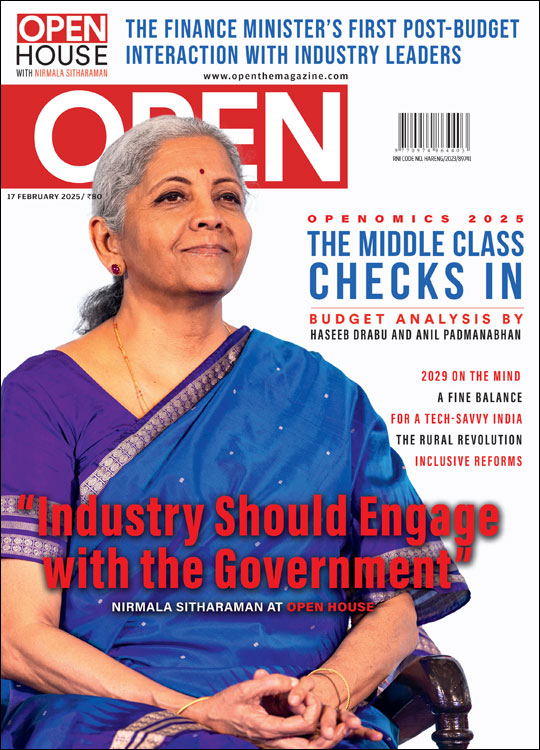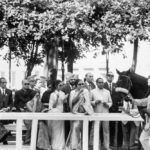A Biography of Indian Currency: From the Vedic to Demonetisation
The origin of money
 Aresh Shirali
Aresh Shirali
 Aresh Shirali
|
22 Dec, 2016
Aresh Shirali
|
22 Dec, 2016
/wp-content/uploads/2016/12/Money1-lead.jpg)
IN THE LONG run, we’ll all be fed— and clad, and housed, and stimulated, and whatever-elsed—under the auspices of a great database that’ll know exactly what we all owe one another. Cash will be a curiosity, coins just spot-lit objects atop pedestals, or flippables best kept for an instant toss-up to settle a dispute, perhaps with the special sort used in Sholay (heads-I-win-tails-what-tails?) finding particular favour. Either way, it would be inevitable, the shift. Nothing forged in a furnace is truly eternal, after all, and with luck ‘Satyamev Jayate’ will be etched more durably in human mindspace than in hard metal, the outcome of a Hegelian dialectic of currency that traces the very arc of civilisation as we know it.
Think about it. If life many millennia ago was cashless and crude, a ‘thesis’ whose ‘anti thesis’ is apparent in a modern life that’s cash- rich and comfortable (at least relatively), isn’t a cashless and comfy life the perfect ‘synthesis’ of history for a new millennium?
The first two dots have already been filled in. The prehistoric farmers who first settled in river basins and came up with harvests of their own sowing did not strut around with bagfuls of moolah. Modern men of immodest means, in contrast, are observed to measure their potency by the bulge of their wallets. But two dots are not enough. To spot a historical trend, it takes three. The first could’ve been happenstance, the second a simple coincidence, and if your name is Bond, the third, the synthesis, may indeed be a case of ‘enemy action’ (as Agent 007’s rule-of-three goes). For, money literally began as a bond, an IOU, a promise of repayment, and its soul, if you will, is all but set to be parted from its body for conversion into a stream of zeroes and ones—dematerialised, that is, into digital information.
Does history endorse this shift? Crude, yes, but was the past really cashless? Are we merely reverting to an ancient norm? Let’s scroll back to another question. How did money emerge in the first place?
The archaeological record is fascinating, not least because the most enigmatic of ancient ‘coins’ ever dug up happen to be Indian. The earliest such example, dated back to about 540 BCE and thus among the planet’s first, is that of a small silver bar punch-marked with official symbols. It may be of Gandharan origin, of a kingdom based in Takshila, though exactly who issued it is still a mystery. Strikingly, however, it appears to be stamped not only with the royal insignia of its original issuer, but with a series of separate ‘counter punches’: this suggests that this was not just cash worth its metallic value as a medium of exchange, plain and simple, but a kind of abstract credit document designed to be endorsed by counter parties for transfer, like a bank draft.
Debt transfers were amazingly advanced back then; even earlier, if old engravings have been interpreted correctly. According to David Graeber, an LSE anthropologist and author of Debt: The First 5000 Years (2011), it was an elaborate system of IOUs being notched across a pre-Axial agrarian economy that gave rise to cash in the first place. ‘The moment one casts matters on a broad historical scale…’ he writes in his book, ‘the first thing one learns is that there’s nothing new about virtual money. Actually, this was the original form of money. Credit systems, tabs, even expense accounts, all existed long before cash. These things are as old as civilization itself.’
The barter theory taught in Economics 101, he argues, is only a fictitious model, a myth that deserves a laugh once it’s weighed against the evidence of anthropology and archaeology. ‘Our standard account of monetary history is precisely backward. We did not begin with barter, discover money and then eventually develop credit systems. It happened precisely the other way around. What we now call virtual money came first. Coins came much later, and their use spread only unevenly, never completely replacing credit systems.’ As Caroline Humphrey of Cambridge once noted: ‘No example of a barter economy, pure and simple, has ever been described, let alone the emergence from it of money; all available ethnography suggests that there has never been such a thing.’ While the world has had societies with no clue of money as a concept—such as South America’s Nukak-Makús and Central America’s Incas—‘barter’ as a practice even among tribals seems to be either a sporadic or festive affair, by and large, rather than the actual basis of a local economy.
What about barter before the advent of agriculture? Niall Ferguson, historian and author of The Ascent of Money (2009), dismisses its likelihood in no uncertain terms. ‘Hunter-gatherers do not trade,’ he writes, ‘They raid.’ Money has always been money, a ‘crystallised relationship between debtor and creditor’ as he defines it in a book that evokes the spirit of John Lennon in its opening line (‘Imagine a world with no money’) and offers the cashless economy of Ancient Mesopotamia as Exhibit A.
The clay tablets found in that cradle of civilisation are an argument clincher for credit having given birth to cash, says Graeber: ‘The most shocking blow to the conventional version of economic history came with the translation, first of Egyptian hieroglyphics, and then of Mesopotamian cuneiform, which pushed back scholars’ knowledge of written history about three millennia… to roughly 3500 BC. What these texts revealed was that credit systems… actually preceded the invention of coinage by thousands of years.’ The tablets in question have been deciphered to show details of who owes who how much and when. So and so, says a typical slab of the 2nd millennium BCE, ‘will pay 350 measures of barley to the bearer at harvest time’. Temple officials would keep closely guarded records of various transactions to be squared off and settled all across the economy.
Debt itself is an idea far older than many think. ‘Even the earliest Vedic poems evince a constant concern with debt—which is treated as synonymous with guilt and sin,’ writes Graeber, citing the Rig Veda in support: ‘Let us drive away the evil effects of bad dreams, just as we pay off our debts’ (8.47.17). He also quotes the Satapatha Brahmana: ‘A man, being born, is a debt; by his own self he is born to Death, and only when he sacrifices does he redeem himself from Death’ (3.6.216). What begins as a moral obligation to repay divinity for the blessings of existence, he posits, creates space over the centuries for this notion to turn into a day-to-day unit of transaction. This is so of every early culture around the world, he insists. It’s telling, he adds, that even the English word ‘pay’ is derived directly from ‘pacify’.
Paying for food and stuff by something that could be passed on, of course, would keep deals nice and simple, and it’s easy to suppose that the invention of coins was only a matter of time and technology. As Ferguson writes of the basic rationale: ‘Money, it is conventional to argue, is a medium of exchange, which has the advantage of eliminating inefficiencies of barter; a unit of account, which facilitates valuation and calculation; and a store of value, which allows economic transactions to be conducted over long periods as well as geographic distances. To perform all these functions optimally, money has to be available, affordable, durable, fungible, portable and reliable.’
Gold, silver and bronze would naturally be best suited for the purpose. And so it was. ‘Coinage appears to have arisen independently in three different places almost simultaneously: on the Great Plains of northern China, in the Ganges river [basin] of India, and in the lands surrounding the Aegean Sea, in each case, between roughly 600 and 500 BC,’ says Graeber. Why was it simultaneous? Now that’s another story altogether.
FOR MORE THAN a thousand years, metal defined the portable power of money, and Indian coins down the ages on display at websites such as CoinIndia.com (the RBI’s museum at Rbi.org.in pales in comparison) offer the most to marvel at. Even a cursory scroll through its panels is worth its weight in gigabytes.
Early Mauryan coins were flattened squares of silver with assorted motifs. It was from Greece, apparently, that round coins found their way here, and the halo effect of this shape seems to play more than a circumferential role in the awe sought to be inspired. Most coins struck by Indo-Greek rulers have a standard format: a king’s bust on one side with a divine figure on the other. A 320 BCE tetradrachm brought along by Alexander’s army bears an owl on one face—an avian species RBI governors like to identify with— and Athena on the obverse. Dozens of others feature a dazzling array of kings and gods carved out in such fine detail, it’s a wonder we’re so lost today about who they were and what sway they held.
Surprisingly few ancient coins bear any iconography one may easily recognise. There is one with a swastika and Brahmi legend around it struck by King Yolamira in the 2nd century BCE. There’s another that has a matt-lock Shiva with a bull and trident, dated back to 195 BCE and issued in gold by a Kushan ruler called Vasu deva I, ‘King of kings’ as its Bactrian legend hails him. But there aren’t too many more. As a deity of wealth, Lakshmi makes her debut on coinage hundreds of years later under the Gupta Dynasty. One splendid example in gold has Chandragupta II on a horse with the deity holding a lotus on the obverse. Depictions of heroic action are de rigeur in this phase. Kumaragupta I appears slaying a lion, for instance, with the monarch portrayed as ‘Sri Mahendrasimha’ in the era’s preferred script, Brahmi. An entire trove of Gupta Dynasty coins was recently unearthed in Tonk district of Rajasthan, setting off a gold rush among goggle-eyed locals before the state police cordoned off the area and called in the Archaeological Survey of India.
Virtual money, say scholars, was indeed the original form of money at the dawn of civilisation. Credit systems gave rise to cash only later
It’s the older coins, however, that offer the real clues to their raison d’etre. Graeber contends that the concept of coinage co-incides with the conquest of far-off territory. Under this hypothesis, it wasn’t the mintability of coins that made their use practical as currency, but imperial expansion and the need to retain large armies on regular payrolls. ‘Coins and markets sprung up, above all, to feed the machinery of war,’ he writes. Instead of trying to haul burdensome provisions along for legions of soldiers out on long campaigns, it was far easier to hand them little pieces of gold and silver—often a share of the loot—which could be used in strange bazaars where they had no credit accounts. The Mauryans, lucky to have silver mines of their own to fund warfare, were masters of this game. Drawing on Chandragupta Maurya’s reign, Graeber quotes Kautilya’s Arthashastra to that effect: ‘The treasury is based upon mining, the army upon the treasury; he who has an army and a treasury may conquer the whole wide earth.’
Ah, but that’s not the end of the Mauryan tale. The peace that followed Emperor Ashoka’s expansion, Graeber suggests, saw a reversal of coinage: credit systems arose and money went virtual again. This is a general pattern seen all through world history, which ‘goes back and forth between periods dominated by bullion— where it’s assumed that gold and silver are money—and periods where money is assumed to be an abstraction, a virtual unit of account.’ Broadly, the anthropologist divides human affairs on earth into four phases for his monetary analysis. If the Age of Agrarian Empires (3500-800 BCE) was one of credit systems, the Axial Age to follow (800 BCE-600 CE) saw bullion and coins take centre-stage amid scenes of war and plunder. The Middle Ages (600-1450 CE), which saw myriad means of finance flourish in large swathes of the world under a pax-Khalifat order, was one of demat settlements once again. Then came the Age of Capitalist Empires (1450-1971 CE) and metal made a big comeback, a phase that lasted for half a millennium until the US declared its dollar no longer redeemable in gold, pushing us into a new transition.
It’s a global generalisation, of course, and Indian history doesn’t quite lend itself to such a neat slice-up of its timeline. While it may be true that most coins were melted for idols or stored away in temples, monastic coffers and so on—the Sree Padmanabhaswamy find of 2011 comes to mind—as credit arose during the Middle Ages, the Subcontinent was also wracked by violence enough to give coins an edge over credit.
Again, some of the artefacts of the period at CoinIndia.com turn out to be eye-poppers. As an early instance of a bilingual coin, there is one struck by Mahmud of Ghazni that’s remarkably legible; dated to 1027-28 CE, it bears the Islamic kalmaa in Arabic followed by him proclaimed as a ‘guardian of the faith’ on one side and described as an avataar of the ‘invisible one’ in Sanskrit on the other. The Delhi Sultanate that took hold of the north a couple of centuries later was marked by ‘considerable expansion of the monetary economy’ according to the RBI’s Monetary Museum, which makes a cautionary mention of the infamous token money issued by Muhammad bin Tughlaq. Struck in brass, a rare surviving 1340-41 CE sample of this coin bears a seal assuring the bearer a value far in excess of its molten worth, together with a stern inscription saying, ‘He who obeys the sultan obeys the Compassionate.’ Once issued to people at large, though, it failed to evoke the requisite piety. Mass forgery of these token coins ensued, reducing their real market value to a pittance. ‘Tughlaq, to his credit, redeemed all tokens, forged or genuine, in specie,’ notes the RBI website.
For token currency to work, clearly, the issuer’s word must hold good in the bazaar. Ferguson puts the point across pithily. ‘Money is not metal,’ he writes, ‘It is trust inscribed.’ No wonder divinity is invoked so frequently in testimony to the cause. Most coins minted by rulers of medieval India feature Islam’s avowal of faith in Arabic calligraphy, the best known being the original rupiya—derived some say from the Sanskrit word ‘roop’ for ‘shape’ or ‘likeness’—of Sher Shah Suri, a 1540-41 CE version of which bears the ruler’s name in Devnagri as well.
Mughal coins retained the broad outline of the rupiya mould, with successive emperors altering the finer details of design to suit their idea of regalia. Jahangir’s coinage seems almost whimsical in its artistic flourishes. One prized sample has him with a wine goblet; it also has Persian poetry that goes, ‘By the name of Jahangir, this coin of Lahore will stay constant in the epoch, up to the heavens of the universe.’ As rumour has it, his favourite queen Noorjahan was the actual force behind the throne, and this gets some credence from a coin treasured by collectors that includes her name in its legend. ‘By the authority of Shah Jahangir, gold gains a hundred beauties by the name of Noorjahan Baadshah Begum,’ it says. On ascending to power, Shah Jahan promptly had these coins recalled and melted, making their use punishable by death. Most people thought it best to comply with this sikkabandi, which explains its rarity today. (As Mitchell-Innes, an early credit-first theorist, observes, ‘So unimportant indeed was coinage that sometimes kings did not hesitate to call it all in for re-minting and re-issue and still commerce went on just the same’.) Oddly for a baadshah who built the Taj Mahal, Shah Jahan’s own coins refrain from flights of fancy, while his son Aurangzeb’s are as austere as one would expect, cluttered with dull inscriptions of where they were minted and when.
If the Mughal era was one of plentiful metal money, the records of the time also have references to vast networks of hundi and hawaala operators who kept the levers of commerce and lines of credit in fine fettle. By one account—it needs corroboration, though—Aurangzeb’s doctrinal attitude to loans resulted in a communal schism that took India’s 18th century economy apart. If riba-bandi didn’t do it, the onset of British Raj certainly did. It’s well known that colonial subjugation, industrial imports and a divide-and-rule policy dealt the economy a severe blow. Some say the old credit systems survived as part of a parallel economy, but proof of this is sketchy.
British imperial cash came about with the Coinage Act of 1835, when a William IV coin bearing a legend in English and Persian was put into circulation. Paper bank notes of the Western kind—an idea taken from China—had already been issued by Bank of Hindostan by then, as also by General Bank of Bengal and Bihar set up by Warren Hastings in the 1770s. The classic George V rupee immortalised by Sholay was issued soon after the Indian Coinage Act of 1906, by which time European banking had taken almost complete charge of the country’s finance sector. According to the RBI, it wasn’t until 1950 that free India had sikkas of its own.
And now, as money starts turning into IOUs zipping around the internet, it’s back to its original function as a measure of value. ‘The intangible character of most money today is perhaps the best evidence of its true nature,’ writes Ferguson, ‘Money is a matter of belief, even faith: belief in the person paying us; belief in the person issuing the money he uses or the institution that honours his cheques and transfers.’ So long as the monetary system is stable and trustworthy, nobody really needs to see the cash. In Graeber’s words, ‘What we are witnessing today is a return of assumptions that would have been considered common sense in, say, the Middle Ages—or even ancient Mesopotamia.’
AS A DREAM, then, a future of cashless comfort has an appeal that goes beyond its technical possibility. But this, alas, is so only in theory. Its inevitability in practice as part of a three- stage historical process can easily be cast in doubt. Just as a life of primitive sharing and poverty that attains modernity in private ownership and unequal wealth need not give us a synthesis of sharing and equality—as Marxist dialectics would expect—even if pushed by an entire state’s machinery, or goaded along by the ‘social credit’ police, this transition could get jinxed by factors ranging from human anxieties to faulty enablers, many of which are apparent to anyone acquainted with ground reality in India.
A cashless economy cannot be decreed. Gradual adoption is the best one can hope for. What’s more, the basic condition for such a major shift, as seen in the cash versus credit see-saw down the ages, is a prolonged phase of peace and amity across the land that would allow everyone to trust one another as much as the system. Arguably, that great big data gig in the sky is much too cloudy for too many. And its enforcement is fraught with peril. If peace eludes us, cashless comfort could end up as just another synthetic ideal mounted on a pedestal of clay.

/wp-content/uploads/2025/02/Cover-Openomics.jpg)













More Columns
A political model that just fell apart Ullekh NP
Gardens of Senses Alka Pande
Why AAP failed to cash in on promise of ₹2100 to Delhi’s women Open